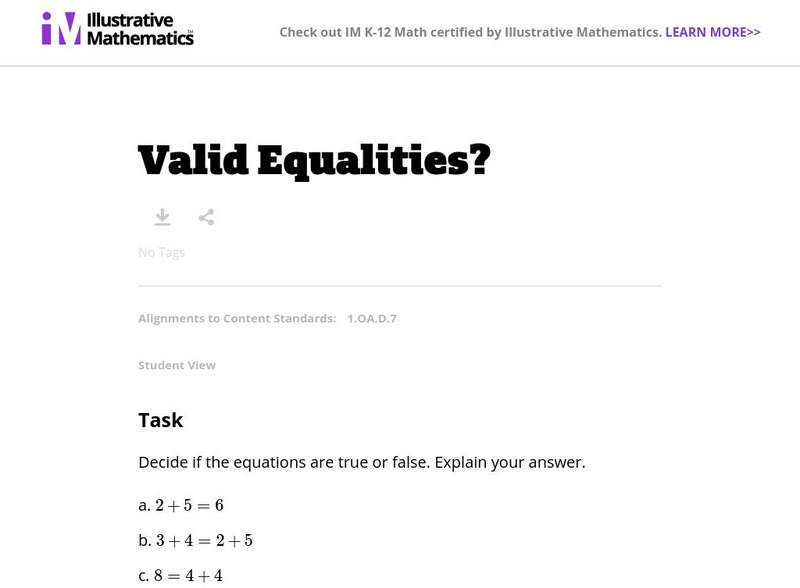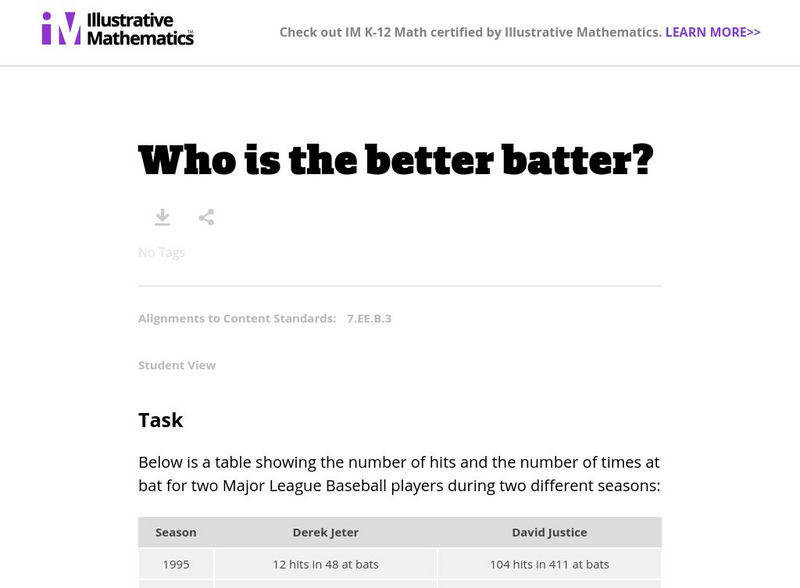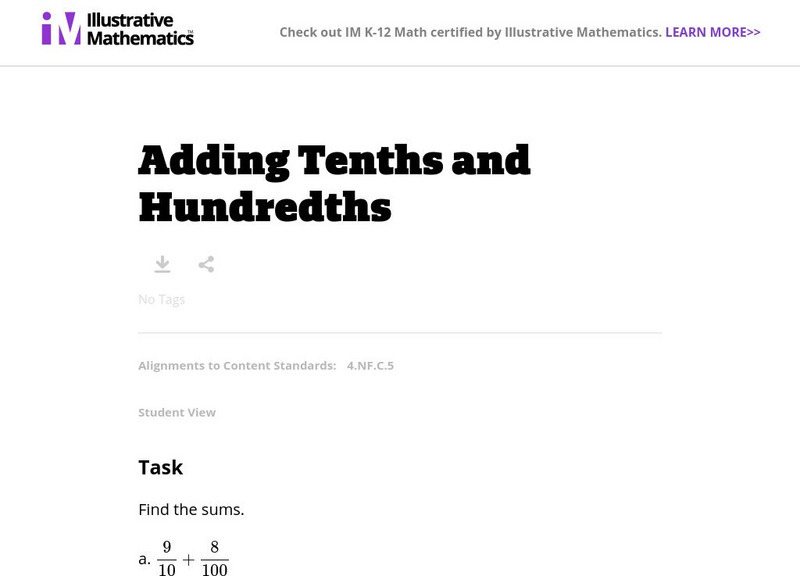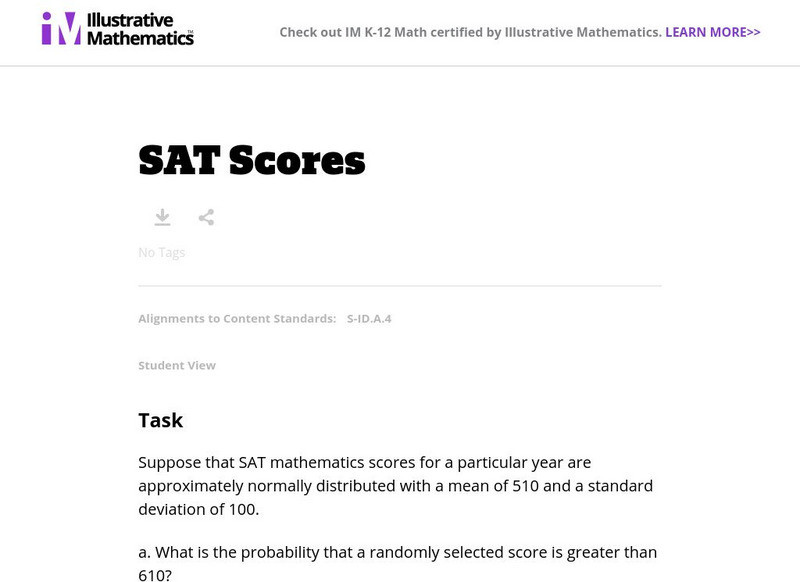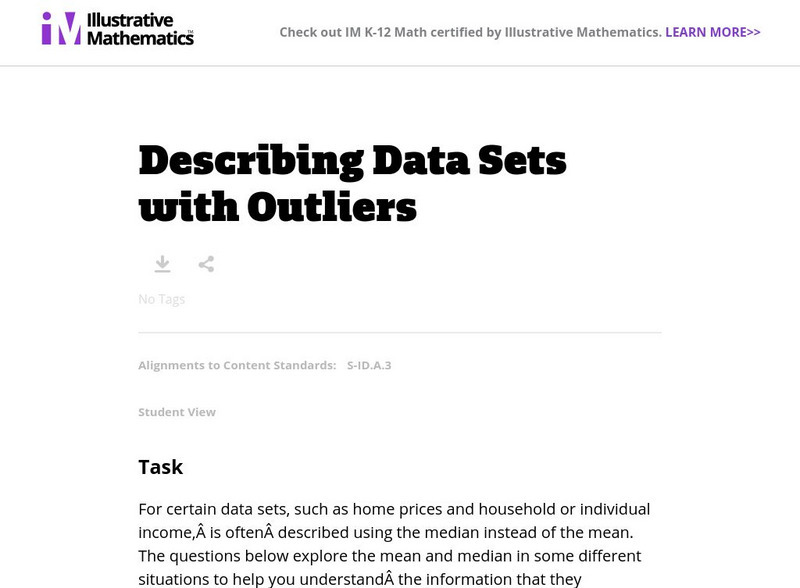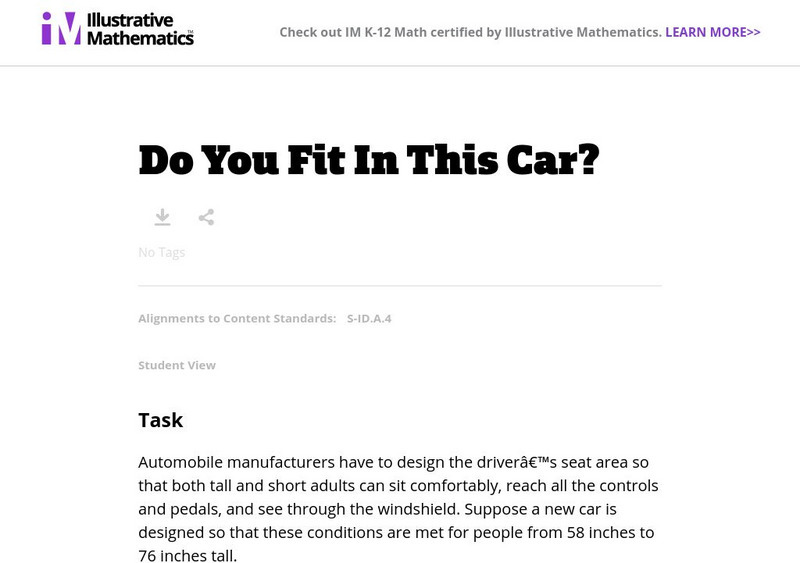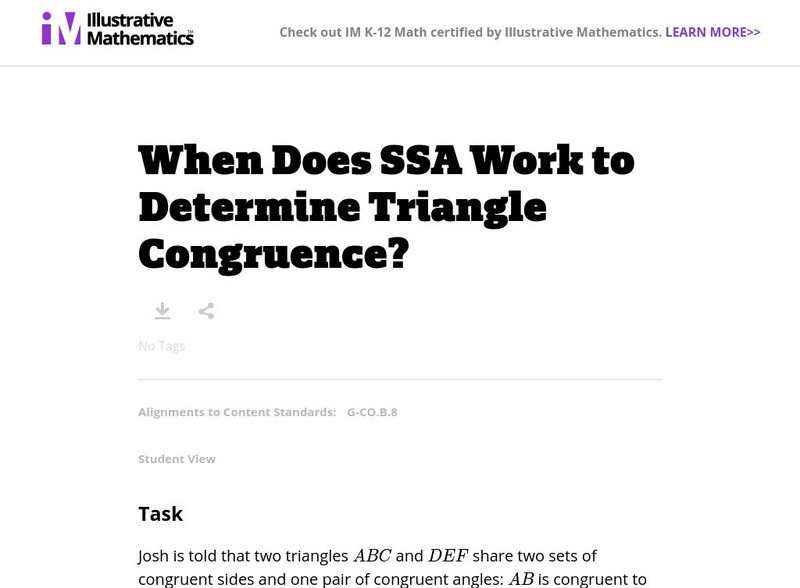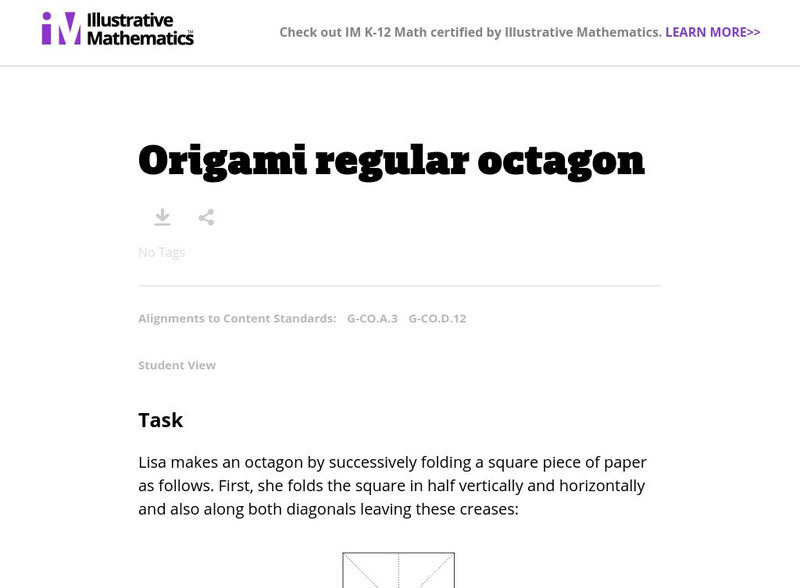Illustrative Mathematics
Illustrative Mathematics: 1.oa Using Lengths to Represent Equality
In this lesson plan, 1st graders determine if lengths are equal to one another.
Illustrative Mathematics
Illustrative Mathematics: 1.oa Valid Equalities?
This lesson plans allows students to explore the meaning of the equal sign in addition and subtraction problems.
Illustrative Mathematics
Illustrative Mathematics: Fractions on a Line Plot
Students will play a game with a partner to create a line plot with fractions.
Illustrative Mathematics
Illustrative Mathematics: 7.ee Who Is the Better Batter?
Seventh graders compare the batting averages of two baseball players in this lesson.
Illustrative Mathematics
Illustrative Mathematics: 4.nf Adding Tenths and Hundredths
Find the sums. Aligns with 4.NF.C.5.
Illustrative Mathematics
Illustrative Mathematics: S cp.a.4, S cp.a.5 and S cp.b.6: The Titanic 3
On April 15, 1912, the Titanic struck an iceberg and rapidly sank with only 710 of her 2,204 passengers and crew surviving. Some believe that the rescue procedures favored the wealthier first class passengers. Other believe that the...
Illustrative Mathematics
Illustrative Mathematics: g.co Reflections and Isosceles Triangles
This task has students link their intuitive notions of symmetries of a triangle with statements proving that said triangle is unmoved by applying certain rigid transformations. The mechanism through which students do this is via...
Illustrative Mathematics
Illustrative Mathematics: S Cp and Md: Return to Fred's Fun Factory (With $.50)
The task is intended to address standards regarding sample space, independence, probability distributions and permutations/combinations. Aligns with S-CP.A.1.
Illustrative Mathematics
Illustrative Mathematics: S Id Haircut Costs
This lesson could be used as an introductory lesson to introduce group comparisons. Being able to use data to compare two groups is an important skill. Students will sketch box plots using the data given about the cost of haircuts for...
Illustrative Mathematics
Illustrative Mathematics: S Id Sat Scores
Students will find solutions for a series of questions based on the assumption that SAT mathematics scores for a particular year are approximately normally distributed with a mean of 510 and a standard deviation of 100. Explanation and...
Illustrative Mathematics
Illustrative Mathematics: Understanding the Standard Deviation
The purpose of this task is to deepen student understanding of the standard deviation as a measure of variability in data distribution. The task is divided into four parts, each of which asks students to think about standard deviation in...
Illustrative Mathematics
Illustrative Mathematics: The Addition Rule
The purpose of this task is to provide practice calculating probabilities in the context of a chance experiment with equally likely outcomes and to allow students to develop the addition rule for calculating the probability of the union...
Illustrative Mathematics
Illustrative Mathematics: S Id.3 Describing Data Sets With Outliers
For certain data sets, such as home prices and household or individual income, is often described using the median instead of the mean. This lesson explores the mean and median in some different situations to help you understand the...
Illustrative Mathematics
Illustrative Mathematics: S Id Math Test Grades
Ari has collected data on how much her classmates study each week and how well they did on their recent math test. Here is part of the data showing the percentage of each group (divided according to hours spent studying) who got B's or...
Illustrative Mathematics
Illustrative Mathematics: S Id.1,2,3 Speed Trap
A statistically-minded state trooper wondered if the speed distributions are similar for cars traveling northbound and for cars traveling southbound on an isolated stretch of interstate highway. Students will use the data collected by...
Illustrative Mathematics
Illustrative Mathematics: S Id.4 Do You Fit in This Car?
Students are tasked with solving a common issue for automobile manufacturers that require the students to use normal distribution as a model for data distribution. They will also use mean and standard deviation to figure out the problem....
Illustrative Mathematics
Illustrative Mathematics: S cp.b.9: Random Walk Iii
The task provides a context of "random walking" to calculate discrete probabilities and represent them on a bar graph. Aligns with S-CP.B.9.
Illustrative Mathematics
Illustrative Mathematics: G Co Why Does Asa Work?
In triangles ABC and ABD, we are given that angle BAC is congruent to angle BAD and angle ABC is congruent to angle ABD. Show that the reflection of the plane about line AB maps triangle ABD to triangle ABC. Aligns with G-CO.B.8.
Illustrative Mathematics
Illustrative Mathematics: G Co When Does Ssa Determine Triangle Congruence?
In this task, we are told that two triangles share two sets of congruent sides and one pair of congruent angles and that these two triangles must be congruent based on the reasoning given. Students are asked to analyze this reasoning to...
Illustrative Mathematics
Illustrative Mathematics: G Co, G Srt Congruence of Parallelograms
In this task, a student has learned the SSS and SAS congruence tests for triangles and wonders if these tests might work for parallelograms. Aligns with G-CO.C.11 and G-SRT.B.5
Illustrative Mathematics
Illustrative Mathematics: G Co Origami Regular Octagon
After successive folds of a piece of origami paper, a student must explain why the shape made is a regular octagon. Aligns with G-CO.A.3 and G-CO.D.12.
Illustrative Mathematics
Illustrative Mathematics: S Id.6 Used Subaru Foresters
Help Jane sell her Forrester! Using the data given, students will make an appropriate plot with well-labeled axes that would allow you to see if there is a relationship between price and age and between price and mileage. Students are...
Illustrative Mathematics
Illustrative Mathematics: S Id.7 Used Subaru Foresters
Jane wants to sell her Subaru Forester and does research online to find other cars for sale in her area. She examines the scatterplot of price versus age and determines that a linear model is appropriate. Answer a variety of questions...
Illustrative Mathematics
Illustrative Mathematics: S Id Golf and Divorce
This is a simple task addressing the distinction between correlation and causation. Students are given information indicating a correlation between two variables and are asked to reason out whether or not a causation can be inferred.

